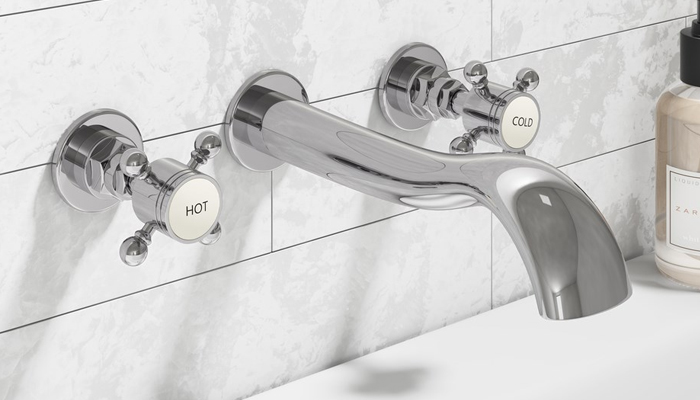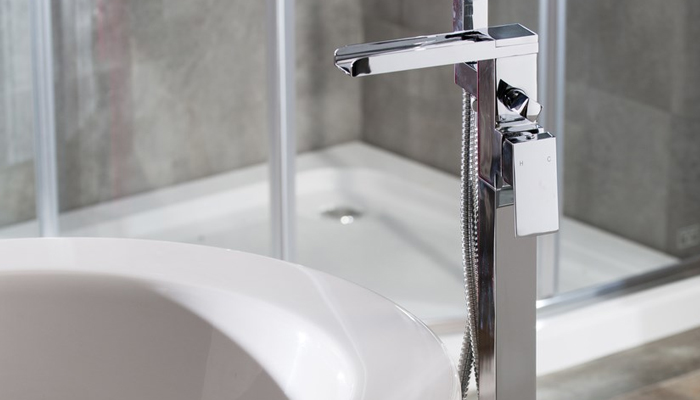
 Ex. VAT
Inc. VAT
Ex. VAT
Inc. VAT  Ex. VAT
Ex. VAT
 €
€  €
€ Taps can transform your bathroom, they are the finishing touch that ties all the elements together. Replacing old taps is a great way to give a tired bathroom a face lift. Those who are DIY savvy can even take on the task themselves. If you decide to get a professional in, it is still an inexpensive and easy way to update your bathroom. From traditional crosshead taps to contemporary waterfall taps, there’s a wide choice, so it can be difficult to know where to start. We’ve put together a quick guide to give you an overview and to make you aware of what to consider when choosing your taps.
Pillar taps  These taps stand side by side, separating the hot and cold water supply. Providing individual control, you decide how much hot and how much cold water to use. They are available in modern styles with lever heads, and traditional styles with cross heads. They are generally suitable for all water pressures but are ideal for low pressure systems. Shop pillar taps »
These taps stand side by side, separating the hot and cold water supply. Providing individual control, you decide how much hot and how much cold water to use. They are available in modern styles with lever heads, and traditional styles with cross heads. They are generally suitable for all water pressures but are ideal for low pressure systems. Shop pillar taps »
Mixer taps  With a single spout these taps mix the hot and cold water supply. They can be controlled by a single lever at the top of the spout which can be turned left or right to adjust temperature or they can have a handle at either side of the spout to control the hot and cold water individually.
With a single spout these taps mix the hot and cold water supply. They can be controlled by a single lever at the top of the spout which can be turned left or right to adjust temperature or they can have a handle at either side of the spout to control the hot and cold water individually.
Shower mixer taps  Just like mixer taps these shower/bath mixer taps provide the hot and cold water supply through a single spout. However they also include a shower hose/flex and a switch/lever, which when pulled redirects the flow from the spout to the shower hose. They let you easily find your preferred water temperature through the spout before switching to shower mode.Shop shower mixer taps »
Just like mixer taps these shower/bath mixer taps provide the hot and cold water supply through a single spout. However they also include a shower hose/flex and a switch/lever, which when pulled redirects the flow from the spout to the shower hose. They let you easily find your preferred water temperature through the spout before switching to shower mode.Shop shower mixer taps »
Waterfall taps  These taps create a contemporary feature in the bathroom and are available for both basins and baths. They are just like mixer taps where the hot and cold water supply are combined, however the spout has a special design where the water flow is visible creating a waterfall like effect. Shop waterfall taps »
These taps create a contemporary feature in the bathroom and are available for both basins and baths. They are just like mixer taps where the hot and cold water supply are combined, however the spout has a special design where the water flow is visible creating a waterfall like effect. Shop waterfall taps »
Wall mounted taps  Wall mounted taps present a clean and seamless look, in both modern and traditional styles. Ideal for basins and baths without pre-drilled tap holes and for situations where you don't want a freestanding tap, they can be a little more costly to install due to the wall drilling required. Generally you'll need a water pressure of at least 0.5 bar for this type of tap.Shop wall mounted taps »
Wall mounted taps present a clean and seamless look, in both modern and traditional styles. Ideal for basins and baths without pre-drilled tap holes and for situations where you don't want a freestanding tap, they can be a little more costly to install due to the wall drilling required. Generally you'll need a water pressure of at least 0.5 bar for this type of tap.Shop wall mounted taps »
Freestanding taps  Freestanding taps stand alone and are ideal for countertop basins and freestanding baths without pre-drilled tap holes. Basin taps are fixed to the countertop or vanity unit of your sink. Bath freestanding or floor-standing taps are mounted on the floor and are tall to reach the rim of the bath. These taps need a water pressure of at least 1.5 bar to work effectively. Shop freestanding taps »
Freestanding taps stand alone and are ideal for countertop basins and freestanding baths without pre-drilled tap holes. Basin taps are fixed to the countertop or vanity unit of your sink. Bath freestanding or floor-standing taps are mounted on the floor and are tall to reach the rim of the bath. These taps need a water pressure of at least 1.5 bar to work effectively. Shop freestanding taps »
Tap Holes Before you start it’s best to look at your basin or bath, as some come with predrilled tap holes and this will influence the types of taps you can choose from. Those with two tap holes will require pillar taps, whereas those with a single tap hole will need a mixer tap. For those with no tap holes you can opt for a freestanding or wall mounted tap.
Shop taps for a single tap hole » Shop taps for two tap holes »
Water Pressure Generally most taps are suitable for water pressures between 0.8 and 1.5 bar, which is standard in the UK. It is good to know your water pressure before purchasing your taps, as there can be some cases where a tap may not be suitable for low or high pressure, it’s best to check the product descriptions. High pressure is considered to be 2.5 bar and above. Low pressure is considered to be 0.3 bar and below, usually this is due to an old boiler such as a gravity fed system. Taps such as floor standing taps aren’t usually suitable for low pressure systems as they need high pressure to force the water up and through the pipe.
Material Your taps need to stand the test of time, so they need to be made out of quality materials. The majority of our taps are made from solid brass with a smooth polished chrome finish, making them highly durable and super easy to wipe clean with a soft non-abrasive cloth, plus they have a lovely shine. It’s important what is inside your taps too. Our taps come with ceramic disc technology to prevent dripping, this also means they only require a ¼ turn to stop the water supply. The ceramic disc technology shouldn’t need maintaining however if you live in a hard water area they may be prone to lime scale build up.
WastesThe waste is the channel designed to allow the water in your basin or bath to drain away. The majority of our taps include a waste which features a click clack plug, just be sure to check the production descriptions. There a few different styles too, enabling you to replace or change your waste.
What type of tap will I need for a countertop basin?
Countertop basins offer a contemporary look without tap holes and taps fitted to them, so they require wall mounted taps or freestanding basin taps which will also mount to the counter.
Shop wall mounted taps » Shop freestanding taps »
What taps are required for a bidet?
If you’re placing a bidet in your bathroom it will require a different type of tap which features a special nozzle at the end of the spout to project the water flow appropriately.
Shop bidet taps »
What is a click clack waste?
Click clack wastes, also known as push button wastes or sprung plugs are the most popular option as they are very easy to use. The plug sits in place constantly and you simply push it down to close the plug and push it again to open the plug. This is also the type of plug which is provided as standard with the majority of our taps.
Do I need a slotted or un-slotted waste?
Basins with an overflow will require a slotted waste, this is because when your basin gets too full the water will flow out of the basins overflow (the small hole on the back wall of the basin) and drain away via the slotted waste. If your basin doesn’t have an overflow which some modern styles do not, then it won’t require a slotted waste and an un-slotted waste can be used.